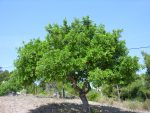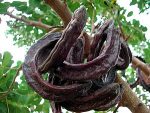 Carob tree, also called St. John’s-bread and locust bean, is a member of the pea family (Fabaceae) and native to Southern Europe, Northern Africa, the Levant, Middle East and Macaronesia . It is cultivated as an ornamental as well as for its pods that can be ground and used in place of cocoa powder. The tree is low-branching, dense, and compact. It has contorted branches, rough dark-brown branches and a rounded crown. The pinnately compound leaves are six to nine inches long and have six to ten oval leaflets one to three inches long. They are leathery, glossy, and dark green above with paler undersides. Red buds open to small yellowish male and female flowers carried in lateral racemes on separate trees in spring. Female flowers produce brown, glossy, flat, narrow, leathery pods four to twelve inches long and containing up to 15 seeds. Both male and female flowers must be present for pod production. The pods are protein-rich , contain up to 40 percent sugar and are produced in abundance every second year from August to October. Carob tree tolerates heat and dry atmosphere as well as urban pollutant and is an excellent choice for a shade or street tree. The genus name, Ceratonia, is from the Greek word keras meaning horn and referring to the seed pods of the carob. The specific epithet, siliqua, is the Latin word meaning pod or husk and refers to the fruit of the tree.
Carob tree, also called St. John’s-bread and locust bean, is a member of the pea family (Fabaceae) and native to Southern Europe, Northern Africa, the Levant, Middle East and Macaronesia . It is cultivated as an ornamental as well as for its pods that can be ground and used in place of cocoa powder. The tree is low-branching, dense, and compact. It has contorted branches, rough dark-brown branches and a rounded crown. The pinnately compound leaves are six to nine inches long and have six to ten oval leaflets one to three inches long. They are leathery, glossy, and dark green above with paler undersides. Red buds open to small yellowish male and female flowers carried in lateral racemes on separate trees in spring. Female flowers produce brown, glossy, flat, narrow, leathery pods four to twelve inches long and containing up to 15 seeds. Both male and female flowers must be present for pod production. The pods are protein-rich , contain up to 40 percent sugar and are produced in abundance every second year from August to October. Carob tree tolerates heat and dry atmosphere as well as urban pollutant and is an excellent choice for a shade or street tree. The genus name, Ceratonia, is from the Greek word keras meaning horn and referring to the seed pods of the carob. The specific epithet, siliqua, is the Latin word meaning pod or husk and refers to the fruit of the tree.
 Type: Evergreen tree
Type: Evergreen tree
Outstanding Feature: Shade, pods
Form: Low branching with round crown
Growth Rate: Slow
Bloom: Small yellowish male and female flowers in lateral racemes on separate trees in spring.
Size: 20-45’ H x 20-55’ W
Light: Sun
Soil: Average, light, moderately moist, well-drained but tolerates less including alkali soil.
Hardiness: Zones 9-11
Care: Thin heads annually in winter; tolerates severe pruning.
Pests and Diseases: Relatively disease and pest resistant
Propagation: Seed, grafting (both very difficult)
Comments: Although growth is slow trees are very long lived.
Photo Credits Wikipedia